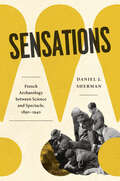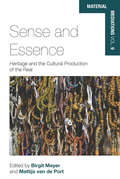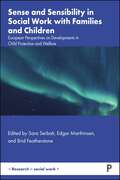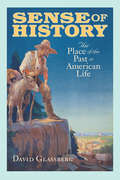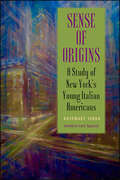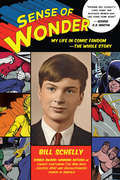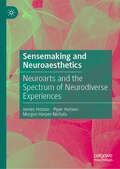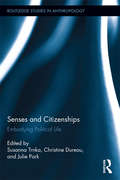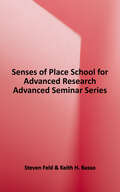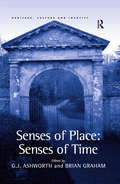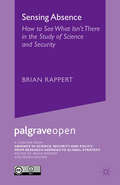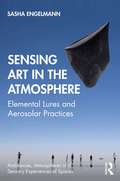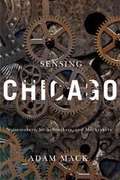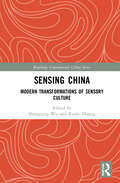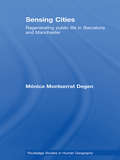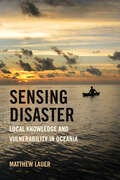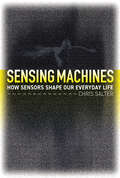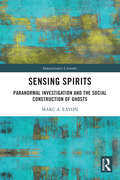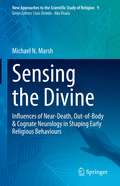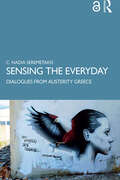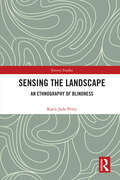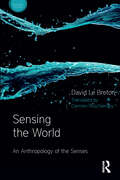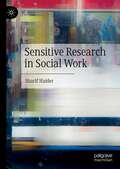- Table View
- List View
Sensations: French Archaeology between Science and Spectacle, 1890–1940
by Daniel J. ShermanDelves into two controversies from the French archaeological world to illuminate the tension between the discipline’s scientific ambitions and its hunger for media attention. For well over a century, from Heinrich Schliemann’s sensational discoveries at Troy in the 1880s, through the Tutankhamun excavations of the 1920s, to the recent LIDAR-aided uncovering of lost Maya cities, archaeology has made headlines. In this new history of archaeology and its archival traces, Daniel J. Sherman treats the friction between science and spectacle as constitutive of the field. By exploring two long-running controversies that roiled the French archaeological world and its wider public in the first third of the twentieth century, he gives the science/media relationship a unique place in the history of archaeology—and its present. The first controversy involves a dispute over the conduct of excavations at Carthage in Tunisia, then under French colonial rule. In the second, accusations of forgery clouded what seemed to be a stunning Neolithic find at a hamlet called Glozel, in the Auvergne region in central France. The affair divided the scholarly community and attracted enormous media attention across Europe and North America. Both controversies occurred at a transitional moment between what has been called the heroic age of archaeology, dominated by explorers and adventurers with little specialized training, and the beginnings of its professionalization. As Sherman shows, the two affairs put the methods, procedures, and networks of archaeology in the spotlight and profoundly shaped its history.
Sense and Essence: Heritage and the Cultural Production of the Real (Material Mediations: People and Things in a World of Movement #9)
by Birgit Meyer Mattijs van de PortContrary to popular perceptions, cultural heritage is not given, but constantly in the making: a construction subject to dynamic processes of (re)inventing culture within particular social formations and bound to particular forms of mediation. Yet the appeal of cultural heritage often rests on its denial of being a fabrication, its promise to provide an essential ground to social-cultural identities. Taking this paradoxical feature as a point of departure, and anchoring the discussion to two heuristic concepts—the "politics of authentication" and "aesthetics of persuasion"—the chapters herein explore how this tension is central to the dynamics of heritage formation worldwide.
Sense and Sensibility
by Jane AustenMarianne Dashwood wears her heart on her sleeve, and when she falls in love with the dashing but unsuitable John Willoughby she ignores her sister Elinor's warning that her impulsive behaviour leaves her open to gossip and innuendo. Meanwhile Elinor, always sensitive to social convention, is struggling to conceal her own romantic disappointment, even from those closest to her. Through their parallel experience of love - and its threatened loss - the sisters learn that sense must mix with sensibility if they are to find personal happiness in a society where status and money govern the rules of love.
Sense and Sensibility in Social Work with Families and Children: European Perspectives on Developments in Child Protection and Welfare (Research in Social Work)
by Sara Serbati, Edgar Marthinsen and Brid FeatherstonePractitioners and managers in child protection often struggle to focus on the needs of children and families in the face of ever-expanding bureaucracy. This book brings together authors from across Europe to explore the strategies and solutions that promote doing things right by those in need rather than to the letter of procedure. It argues that more flexible, community/relationship/partnership-based approaches are required to meet the needs of parents and children experiencing difficulties and risk of harm. Essential reading for academics, practitioners, managers and policy makers in social work and child welfare, it contributes to the development of reflective thinking and spotlights the potential of co-production and co-creation.
Sense of History: The Place of the Past in American Life
by David GlassbergAs Americans enter the new century, their interest in the past has never been greater. In record numbers they visit museums and historic sites, attend commemorative ceremonies and festivals, watch historically based films, and reconstruct family genealogies. The question is, Why? What are Americans looking for when they engage with the past? And how is it different from what scholars call "history"? In this book, David Glassberg surveys the shifting boundaries between the personal, public, and professional uses of the past and explores their place in the broader cultural landscape. Each chapter investigates a specific encounter between Americans and their history: the building of a pacifist war memorial in a rural Massachusetts town; the politics behind the creation of a new historical festival in San Francisco; the letters Ken Burns received in response to his film series on the Civil War; the differing perceptions among black and white residents as to what makes an urban neighborhood historic; and the efforts to identify certain places in California as worthy of commemoration. Along the way, Glassberg reflects not only on how Americans understand and use the past, but on the role of professional historians in that enterprise. Combining the latest research on American memory with insights gained from Glassberg's more than twenty years of personal experience in a variety of public history projects, Sense of History offers stimulating reading for all who care about the future of history in America.
Sense of Origins: A Study of New York's Young Italian Americans (SUNY series in Italian/American Culture)
by Rosemary SerraIn Sense of Origins, Rosemary Serra explores the lives of a significant group of self-identified young Italian Americans residing in New York City and its surrounding areas. The book presents and examines the results of a survey she conducted of their values, family relationships, prejudices and stereotypes, affiliations, attitudes and behaviors, and future perspectives of Italian American culture. The core of the study focuses on self-identification with Italian cultural heritage and analyzes it according to five aspects—physical, personality, cultural, psychological, and emotional/affective.The data provides insights into today's young Italian Americans and the ways their perception of reality in everyday interactions is affected by their heritage, while shedding light on the value and symbolic references that come with an Italian heritage. Through her rendering of relevant facets that emerge from the study, Serra constructs interpretative models useful for outlining the physiognomy and characterization of second, third, fourth, and fifth generations of Italian Americans. In the current climate, questions of ethnicity and migrant identity around the world make Sense of Origins useful not only to the Italian American community but also to the descendants of the innumerable present-day migrants who find themselves living in countries different from those of their ancestors. The book will resonate in future explorations of ethnic identity in the United States.
Sense of Wonder: My Life in Comic Fandom--The Whole Story
by Bill SchellyA fascinating story of growing up as a gay fan of comic books in the 1960s, building a fifty-year career as an award-winning writer, and interacting with acclaimed comic book legendsAward-winning writer Bill Schelly relates how comics and fandom saved his life in this engrossing story that begins in the burgeoning comic fandom movement of the 1960s and follows the twists and turns of a career that spanned fifty years. Schelly recounts his struggle to come out at a time when homosexuality was considered a mental illness, how the egalitarian nature of fandom offered a safe haven for those who were different, and how his need for creative expression eventually overcame all obstacles. He describes living through the AIDS epidemic, finding the love of his life, and his unorthodox route to becoming a father. He also details his personal encounters with major talents of 1960s comics, such as Steve Ditko (co-creator of Spider-Man), Jim Shooter (writer for DC and later editor-in-chief of Marvel Comics), and Julius Schwartz (legendary architect of the Silver Age of comics).
Sensemaking and Neuroaesthetics: Neuroarts and the Spectrum of Neurodiverse Experiences
by James Hutson Piper Hutson Morgan Harper-NicholsThis book investigates the complex interrelationships between neuroscience, arts, technical design, and the spectrum of neurodivergent conditions, introducing the emerging topic of neuroarts. It emphasizes the power of art and technologies as a multisensory tool for helping neurodivergent individuals discover their sensory preferences, and for neurotypical individuals to broaden their understanding of the world by simulating different sensory experiences. Drawing on the enactivism theory, which posits that cognitive processes are inherently shaped through the dynamic interplay between an organism and its environmental context, the authors discuss the applications of emerging technologies and propose a new theory to discuss and identify ‘neurotribes’ based on their relation to sense making or the body.A timely and well-needed resource for scholars in the fields of neuroaesthetics and neurodiversity, as well as art therapists, clinical psychologists, and medical practitioners specializing in neurodiversity and sensory perception disorders, this book can also serve cultural institutions developing inclusive experiences for a neurodiverse public, and professionals in the tech industry focusing on AI, augmented reality, and sensory technology.
Senses and Citizenships: Embodying Political Life (Routledge Studies in Anthropology #10)
by Julie Park Susanna Trnka Christine DureauWhat does disgust have to do with citizenship? How might pain and pleasure, movement, taste, sound and smell be configured as aspects of national belonging? Senses and Citizenships: Embodying Political Life examines the intersections between sensory phenomena and national and supra-national forms of belonging, introducing the new concept of sensory citizenship. Expanding upon contemporary understandings of the rights and duties of citizens, the volume presents anthropological investigations of the sensory aspects of participation in collectivities such as face-to-face communities, ethnic groups, nations and transnational entities. Rethinking relationships between ideology, aesthetics, affect and bodily experience, the authors reveal the multiple political effects of the senses. The book demonstrates how various elements of political life, including some of the most fundamental aspects of citizenship, rest not only upon our senses, but on their perceived naturalization. Vivid ethnographic examples of sensory citizenship in Europe, the United States, the Pacific, Asia and the Middle East explore themes such as sight in political constructions; smell and ethnic conflict; pain in the constitution of communities; national soundscapes; taste in national identities; movement, memory and emplacement.
Senses of Place (School for Advanced Research Advanced Seminar)
by Keith H. Basso Steven FeldThe complex relationship of people to places has come under increasing scholarly scrutiny in recent years as acute global conditions of exile, displacement, and inflamed borders-to say nothing of struggles by indigenous peoples and cultural minorities for ancestral homelands, land rights, and retention of sacred places-have brought the political question of place into sharp focus. But to date, little attention has been paid to the ethnography of place, to how people actually live in, perceive, and invest with meaning the places they call home. In this compelling new volume, eight respected ethnographers explore and lyrically evoke the ways in which people experience, express, imagine, and know the places in which they live. <p><p>Case studies range from the Apaches of Arizona's White Mountains to the residents of backwoods "hollers" in Appalachia and the Kaluli people of New Guinea's rain forests. As these writers confront the dilemmas and possibilities of an anthropological consideration of place, they make an important and moving contribution to our understanding of ourselves.
Senses of Place: Senses of Time (Heritage, Culture and Identity)
by G.J. AshworthBringing together case studies from Ireland, the Netherlands, Canada, Germany and Mexico, this book examines the link between senses of place and senses of time. It suggests that not only do place identities change through time, but imagined pasts also provide resources which the present selects and packages for its own contemporary purposes and for forwarding to imagined futures. The reasons behind the creation of place image are also explored, setting them within political and social contexts. In its three main sections - Heritage in the Creation of Senses of Place; Heritage and Conflicting Identities; and Heritage and the Creation of Senses of Place - the book examines the creation of place identities at the urban, rural, regional and international scales. It questions how senses of place interact with senses of ethnic/cultural identity, what the roles of government, media, residents and tourists are in creating senses of place, and how and why all these variables change through time.
Sensible Objects: Colonialism, Museums and Material Culture (Wenner-Gren International Symposium Series #5)
by Elizabeth EdwardsAnthropologists of the senses have long argued that cultures differ in their sensory registers. This groundbreaking volume applies this idea to material culture and the social practices that endow objects with meanings in both colonial and postcolonial relationships. It challenges the privileged position of the sense of vision in the analysis of material culture. Contributors argue that vision can only be understood in relation to the other senses. In this they present another challenge to the assumed western five-sense model, and show how our understanding of material culture in both historical and contemporary contexts might be reconfigured if we consider the role of smell, taste, touch and sound, as well as sight, in making meanings about objects.
Sensing Absence: Chapter 1 from Absence in Science, Security and Policy
by Brian RappertChapter 1 of this book is open access under a CC BY license.This is a chapter from Absence in Science, Security and Policy edited by Brian Rappert and Brian Balmer. This chapter is available open access under a CC BY license. Part reflection on the forthcoming chapters, part analysis of academic literature, and part programmatic agenda setting, this introduction chapter forwards the importance of questioning taken for granted assumptions in sensing what is absent as a concern. It undertakes this through initially examining what it means to characterize concern as absent or present in the first place. While absence and presence are often treated as binary opposites, it will be argued this distinction is difficult to sustain and unhelp for analysis. On the back of an appreciation of the inter-relation of absence and presence, this chapter then reviews the literature in sociology, ethics, STS and elsewhere relevant to the themes of the volume. A goal is to outline the methodological and epistemological possibilities and problematics of studying what is missing. By way of then proposing what is required, and to set the stage for the other chapters in Part 1, this chapter ends by asking how autostereograms provide a metaphor for viewing that can guide the study of absence.
Sensing Art in the Atmosphere: Elemental Lures and Aerosolar Practices (Ambiances, Atmospheres and Sensory Experiences of Spaces)
by Sasha EngelmannThis book engages artistic interventions in the aerial elements to investigate the aesthetics and politics of atmosphere. Sensing Art in the Atmosphere: Elemental Lures and Aerosolar Practices traces the potential of artistic, community-driven experiments to amplify our sensing of atmosphere, marrying attentions to atmospheric affect with visceral awareness of the materials, institutions and processes hovering in the air. Drawing on six years of practice-led research with artistic and activist initiatives Museo Aero Solar and Aerocene, initiated by artist Tomás Saraceno, each chapter develops creative relations to atmosphere from the studio to stratospheric currents. Through narrative-led writing, the voices of artists and collaborators are situated and central. In dialogue with these aerographic stories and sites, the book develops a notion of elemental lures: the sensual and imaginative propositions of aerial, atmospheric and meteorological phenomena. The promise of elemental lures, Engelmann suggests, is to reconcile our sensing of atmosphere with the myriad social, cultural and political forces suspended in it. Through tales of floating journeys, shared envelopes of breath and surreal levitations, the book foregrounds the role of art in crafting alternative modes of perceiving, moving and imagining (in) the air. The book ends with a call for elemental experiments in the geohumanities. It makes an important and original contribution to elemental geographies, the geohumanities and interdisciplinary scholarship on air and atmosphere.
Sensing Chicago: Noisemakers, Strikebreakers, and Muckrakers
by Adam MackA hundred years and more ago, a walk down a Chicago street invited an assault on the senses. Untiring hawkers shouted from every corner. The manure from thousands of horses lay on streets pooled with molasses and puddled with kitchen grease. Odors from a river gelatinous and lumpy with all manner of foulness mingled with the all-pervading stench of the stockyard slaughterhouses. In Sensing Chicago, Adam Mack lets fresh air into the sensory history of Chicago in the nineteenth and early twentieth centuries by examining five events: the Chicago River, the Great Fire, the 1894 Pullman Strike, the publication of Upton Sinclair's The Jungle, and the rise and fall of the White City amusement park. His vivid recounting of the smells, sounds, and tactile miseries of city life reveals how input from the five human senses influenced the history of class, race, and ethnicity in the city. At the same time, he transports readers to an era before modern refrigeration and sanitation, when to step outside was to be overwhelmed by the odor and roar of a great city in progress.
Sensing China: Modern Transformations of Sensory Culture (Routledge Contemporary China Series)
by Shengqing Wu and Xuelei HuangThis book presents the first collection of studies of the senses and sensory experiences in China, filling a gap in sensory research while offering new approaches to Chinese Studies. Bringing together 12 chapters by literary scholars and historians, this book critically interrogates the deeply rooted meanings that the senses have coded in Chinese culture and society. Built on an exploration of the sensorium in early Chinese thought and late imperial literature, this book reveals the sensory manifestations of societal change and cultural transformation in China from the nineteenth century to the present day. It features in-depth examinations of a variety of concepts, representations, and practices, including aural and visual paradigms in ancient Chinese texts; odours in Ming-Qing literature and Republican Shanghai; the tactility of kissing and the sonic culture of community singing in the Republican era; the socialist sensorium in art, propaganda, memory, and embodied experiences; and contemporary-era multisensory cultural practices. Engaging with the exciting "sensory turn," this original work makes a unique contribution to the world history of the senses, and will be a valuable resource to scholars and students of Chinese Literature, History, Cultural Studies, and Media.
Sensing Cities: Regenerating Public Life in Barcelona and Manchester (Routledge Studies in Human Geography #14)
by Monica DegenAs cities globally re-design their urban landscapes, they produce a different urban aesthetic and create new experiential milieus. Urban regeneration processes generate radical physical, social and cultural changes in neighbourhoods that demand new conceptual frameworks to address their impact upon daily urban life. Sensing Cities investigates the reconfiguration of contemporary public space and life through the prism of the senses. The book explores how the increased stylization of cityscapes requires an understanding of public life as a spatial-sensuous encounter. Degen examines how power relations in public spaces are embedded in, exercised and resisted through the sensuous geography of place. This sensory paradigm is then applied to compare two emblematic regeneration projects, namely el Raval in Barcelona and Castlefield in Manchester. By combining detailed ethnographic analysis and interviews with those involved in planning regeneration processes and those experiencing them, the book argues that a changing sensuous landscape is crucial in redefining people’s social practices, attachments and experiences in places. Focusing on two European cities at the forefront of urban design, Barcelona and Manchester, Degen draws on sociology, geography, anthropology, cultural and architectural studies to provide a critical account of the politics of publicness in the entrepreneurial city. With numerous photographs and maps this book stresses the ongoing, embodied and active nature of regeneration as a lived social process rather than merely a physical or economic exercise. Ultimately, Sensing Cities examines how urban regeneration is made effective through the organisation of sensory experience. This book is essential reading for students and researchers of Architecture, Urban Studies and Human Geography.
Sensing Disaster: Local Knowledge and Vulnerability in Oceania
by Matthew LauerIn 2007, a three-story-high tsunami slammed the small island of Simbo in the western Solomon Islands. Drawing on over ten years of research, Matthew Lauer provides a vivid and intimate account of this calamitous event and the tumultuous recovery process. His stimulating analysis surveys the unpredictable entanglements of the powerful waves with colonization, capitalism, human-animal communication, spirit beings, ancestral territory, and technoscientific expertise that shaped the disaster’s outcomes. Although the Simbo people had never experienced another tsunami in their lifetimes, nearly everyone fled to safety before the destructive waves hit. To understand their astonishing response, Lauer argues that we need to rethink popular and scholarly portrayals of Indigenous knowledge to avert epistemic imperialism and improve disaster preparedness strategies. In an increasingly disaster-prone era of ecological crises, this provocative book brings new possibilities into view for understanding the causes and consequences of calamity, the unintended effects of humanitarian recovery and mitigation efforts, and the nature of local knowledge.
Sensing Machines: How Sensors Shape Our Everyday Life
by Chris SalterHow we are tracked, surveilled, tantalized, and seduced by machines ranging from smart watches and Roombas to immersive art installations.Sensing machines are everywhere in our world. As we move through the day, electronic sensors and computers adjust our thermostats, guide our Roombas, count our steps, change the orientation of an image when we rotate our phones. There are more of these electronic devices in the world than there are people—in 2020, thirty to fifty billion of them (versus 7.8 billion people), with more than a trillion expected in the next decade. In Sensing Machines, Chris Salter examines how we are tracked, surveilled, tantalized, and seduced by machines ranging from smart watches and mood trackers to massive immersive art installations. Salter, an artist/scholar who has worked with sensors and computers for more than twenty years, explains that the quantification of bodies, senses, and experience did not begin with the surveillance capitalism practiced by Facebook, Amazon, Netflix, and Google but can be traced back to mathematical and statistical techniques of the nineteenth century. He describes the emergence of the &“sensed self,&” investigating how sensor technology has been deployed in music and gaming, programmable and immersive art environments, driving, and even eating, with e-tongues and e-noses that can taste and smell for us. Sensing technology turns our experience into data; but Salter&’s story isn&’t just about what these machines want from us, but what we want from them—new sensations, the thrill of the uncanny, and magic that will transport us from our daily grind.
Sensing Spirits: Paranormal Investigation and the Social Construction of Ghosts (Interactionist Currents)
by Marc A. EatonBased on ethnographic research, this book examines the paranormal investigation subculture in the US. Presenting interviews with investigators as well as extensive field observations, it explores their reasons for getting involved, their use of different investigative methods, the interpretive processes by which they individually and collectively ‘sense’ spirits, the ways in which these processes are influenced by small group power dynamics, and what paranormal investigation ultimately means to those who participate. While focusing on the practices by which investigators ‘sense’ spirits in small groups, the author also situates paranormal investigation within a broader cultural context and attends to how investigators attempt to legitimize their practice despite being marginalized by both science and religion. A fascinating study of ghosts as an inherently social phenomenon, Sensing Spirits will appeal to sociologists with interests in ethnography, interactionism, cultural studies and subcultures.
Sensing the Divine: Influences of Near-Death, Out-of-Body & Cognate Neurology in Shaping Early Religious Behaviours (New Approaches to the Scientific Study of Religion #9)
by Michael N. MarshThis book proposes another unique basis for the origins of religion from disturbances in brain function. It proposes the novel idea that near-death and out-of-body experiences (ND/OBE) engendered “a sense of the divine” in ancient man.As the author points out, key aspects of ND/OBE are thematic of all later established religions. These include journeys to heaven, sightings of brightly-lit godlike figures, and dead people now alive. Thus, ND/OBE could be the originating source of these spiritual motifs. To this, the author adds a fourth factor: various brain influences contribute to or modulate ND/OBE. Such cognate neurological disorders include REM-sleep intrusions, sleep paralysis, narcolepsy, and the Guillain-Barré syndrome. Errors due to aberrant switching between key neural control centers disrupt critical state-boundaries between consciousness and dreaming. This may induce NDE. Thus, in this state, subjects temporarily fail to understand where they are, undergo loss of self, and detached from the world. They imagine a “union with Gods.” Here, then, is the biological basis of ineffability.Ancient humans gained beliefs about the "supernatural" through day-to-day existence. This book argues that near death experiences and cognate neurological conditions, some genetically-determined, could have facilitated, even augmented such beliefs. Hence, in configuring another realm of “spiritual” experience beyond the known environment, these neurological possibilities offer effective traction.
Sensing the Everyday: Dialogues from Austerity Greece (Theorizing Ethnography)
by C. Nadia SeremetakisSensing the Everyday is a multi-sited ethnographic inquiry based on fieldwork experiences and sharp everyday observations in the era of crisis. Blending sophisticated theoretical analyses with original ethnographic data, C. Nadia Seremetakis journeys from Greece to Vienna, Edinburgh, Albania, Ireland, and beyond. Social crisis is seen through its transnational multiplication of borders, thresholds and margins, divisions, and localities as linguistic, bodily, sensory, and performative sites of the quotidian in process. The book proposes everyday life not as a sanctuary or as a recessed zone distanced from the structural violence of the state and the market, but as a condition of im/possibility, unable to be lived as such, yet still an encapsulating habitus. There the impossibility of the quotidian is concretized as fragmentary and fragmenting material forces. Seremetakis weaves together topics as diverse as borders and bodies, history and death, the earth and the senses, language and affect, violence and public culture, the sociality of dreaming, and the spatialization of the traumatic, in a journey through antiphonic witnessing and memory. Her montage explores various ways of juxtaposing reality with the irreal and the imaginal to expose the fictioning of social reality. The book locates her approach to ethnography and the ‘native ethnographer’ in wider anthropological and philosophical debates, and proposes a dialogical interfacing of theory and practice, the translation of academic knowledge to public knowledge
Sensing the Landscape: An Ethnography of Blindness (Sensory Studies)
by Karis Jade PettyThis book examines how vision impaired walkers experience and engage with the English countryside through five sensory activities: walking, seeing, listening, seeing in the mind’s eye, and touching. Journeying through woodland and fields, the chapters reveal a landscape alive with memory, the imagination, and suffused with shifting temporalities. Karis Jade Petty develops the concepts of inclusive sensoriality and sensorial emplacement, which enable us to revise our understandings of the sensory organisations of experience, animate conceptualisations of landscape, and rethink self-landscape relationality. Reimagining notions of vision and the boundedness of the sensory body, this book will be relevant to scholars from a number of disciplines, including anthropology, sociology, geography, visual studies, disability studies, and sensory studies more broadly.
Sensing the World: An Anthropology of the Senses (Sensory Studies)
by David Le BretonSensing the World: An Anthropology of the Senses is a highly original and comprehensive overview of the anthropology and sociology of the body and the senses. Discussing each sense in turn – seeing, hearing, touch, smell, and taste – Le Breton has written a truly monumental work, vast in scope and deeply engaging in style. Among other pioneering moves, he gives equal attention to light and darkness, sound and silence, and his disputation of taste explores aspects of disgust and revulsion. Part phenomenological, part historical, this is above all a cultural account of perception, which returns the body and the senses to the center of social life. Le Breton is the leading authority on the anthropology of the body and the senses in French academia. With a repute comparable to the late Pierre Bourdieu, his 30+ books have been translated into numerous languages. This is the first of his works to be made available in English. This sensuously nuanced translation of La Saveur du monde is accompanied by a spicy preface from series editor David Howes, who introduces Le Breton's work to an English-speaking audience and highlights its implications for the disciplines of anthropology, sociology, and the cross-disciplinary field of sensory studies.
Sensitive Research in Social Work
by Sharif HaiderThis book addresses issues related with researching sensitive topics in social work, focusing on marginalized, vulnerable and hard to reach people. It covers the definition, characteristics, challenges and opportunities of sensitive research, its philosophical roots and methodological debates, and the skills and values that are required along with the ethical, political and legal issues involved in conducting social work research. This book will cover innovative research methods appropriate for research on sensitive topics involving vulnerable people. It shines light on how to use traditional research methods sensitively, and how to generate data while minimizing the harm that can potentially be caused to research participants and researchers.
